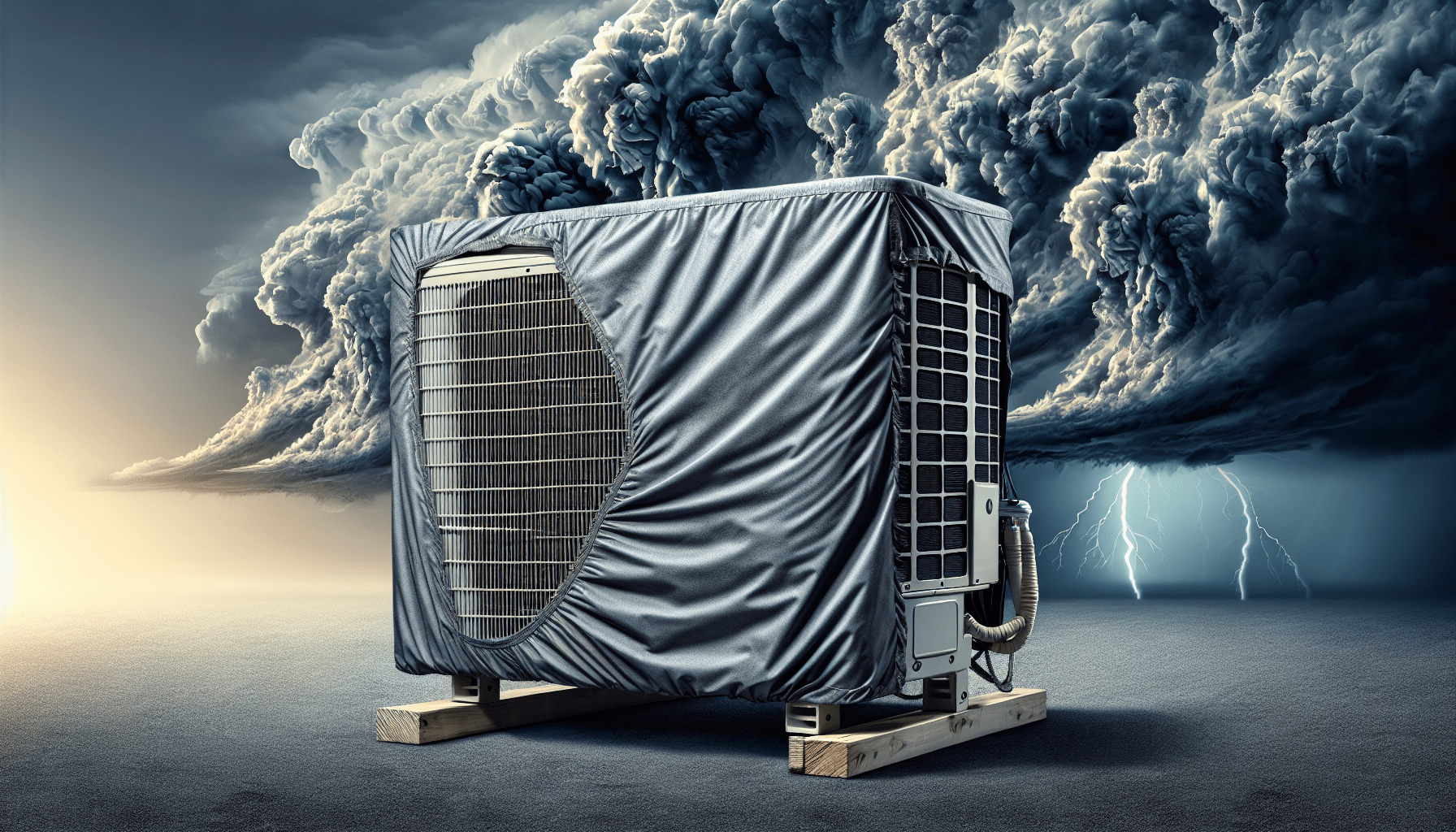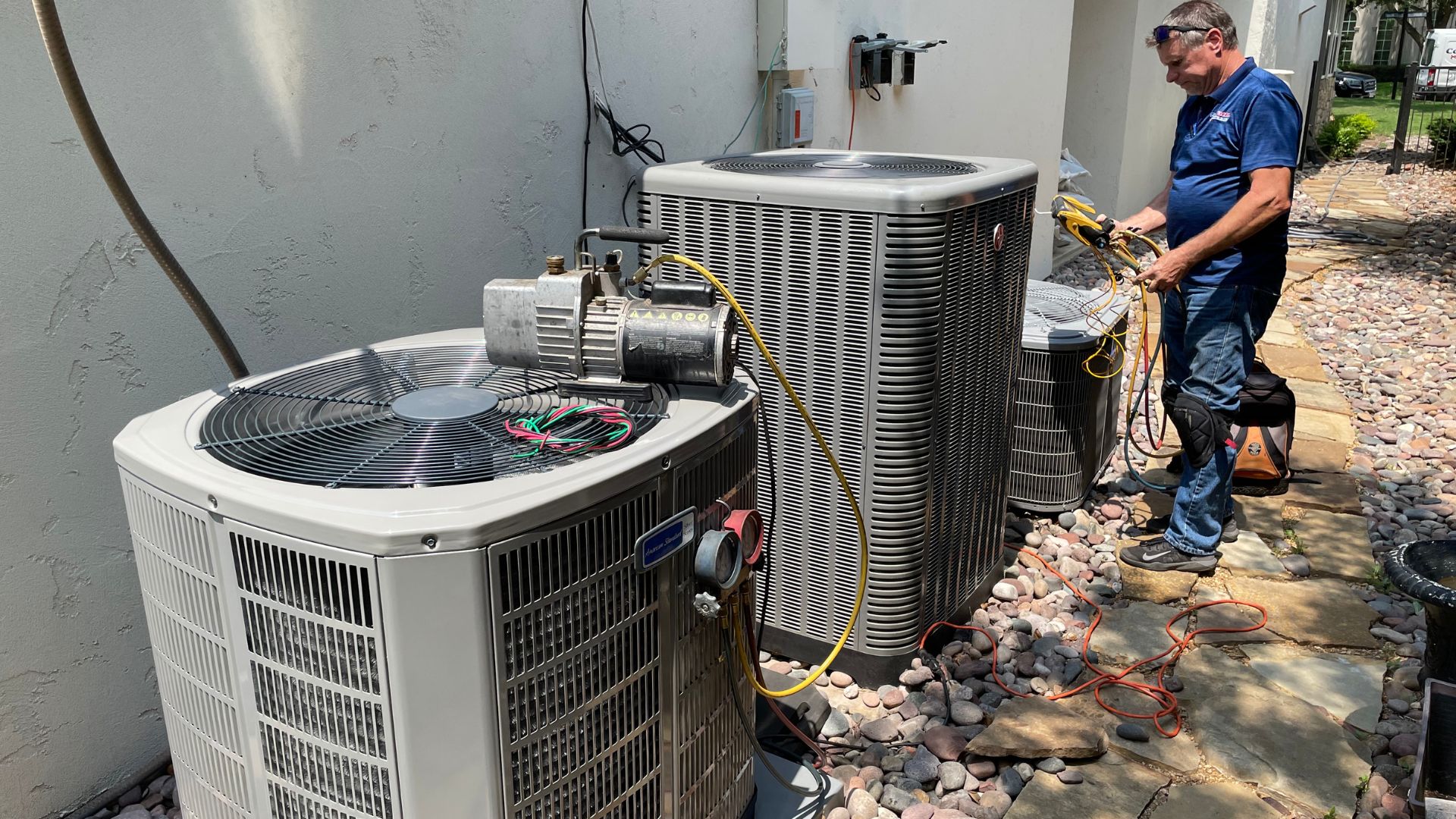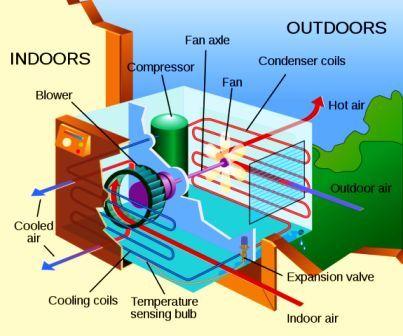Did you know that severe weather can cause damage to your air conditioning unit? It’s true! From heavy rain and strong winds to extreme temperatures, your AC unit is at risk. But don’t worry, there are steps you can take to protect your investment and ensure your unit stays in top-notch condition. In this article, we will explore the best ways to shield your air conditioning unit from severe weather, so you can enjoy cool and comfortable indoor temperatures all year round.

Understanding the Impact of Severe Weather on AC Units
Severe weather conditions can have a significant impact on the performance and longevity of your air conditioning (AC) unit. It is important to understand the types of weather that can adversely affect these units, the consequences of weather damage on AC performance, and the long-term costs associated with weather-damaged AC units.
Types of weather that adversely affect AC units
Several types of severe weather can pose a threat to your AC unit. High winds, such as those experienced during hurricanes, tornadoes, or windstorms, can cause damage to the external components of the unit. Hailstorms can dent or puncture the metal fins of the condenser coils, impairing their ability to dissipate heat. Heavy rain, snow, or flooding can damage electrical components, causing a potential risk of electrical shorts or total failure. Extreme temperatures, whether excessively hot or cold, can put a strain on the AC unit and reduce its efficiency.
Consequences of weather damage on AC performance
When an AC unit sustains weather damage, its performance and efficiency can be compromised. Damaged condenser coils may struggle to release heat, causing the unit to exert more energy and potentially overheat. Electrical damage can result in malfunctions or failure of the unit, leading to expensive repairs or replacement. Additionally, if the AC unit is unable to maintain the desired temperature due to weather damage, it can result in discomfort and reduced indoor air quality.
Long-term costs associated with weather-damaged AC units
The long-term costs of operating a weather-damaged AC unit can quickly add up. Inefficient performance can cause an increase in utility bills as the unit consumes more energy to compensate for the damage. Repairs and maintenance costs are likely to be higher for a damaged unit, especially if the damage is neglected and worsens over time. Ultimately, the lifespan of a weather-damaged AC unit may be significantly shorter, leading to the need for premature replacement and further financial strain.
Regular Maintenance and Inspection
Regular maintenance and inspection of your AC unit are essential to ensure its optimal performance and to detect any potential issues before they worsen.
Importance of regular AC unit inspection
Regular inspection of your AC unit allows you to identify any signs of wear and tear, damage, or potential problems. By catching these issues early on, you can prevent them from escalating and causing further damage to the unit. Inspections also provide an opportunity to clean the unit, remove any debris or obstruction, and ensure that all components are in good working condition.
Scheduling routine professional maintenance
While self-inspections are valuable, it is equally important to schedule routine professional maintenance for your AC unit. HVAC technicians are trained to identify and address issues that may go unnoticed during a self-inspection. They have the knowledge and expertise to perform more comprehensive tests, clean and lubricate internal components, check refrigerant levels, and make any necessary adjustments or repairs.
Self-inspection tips: what to look for in your AC unit
In between professional maintenance visits, you can conduct self-inspections to keep an eye on your AC unit. Start by visually inspecting the exterior for any visible damage, such as dents, bent fins, or signs of corrosion. Check for any loose or damaged electrical connections and ensure that the condensate drain line is clear of any blockages. Listen for any unusual sounds, such as grinding or squealing, and pay attention to any irregular temperature fluctuations in your home. If you notice any issues or abnormalities, it is best to consult a professional technician for further evaluation.
Covering the Unit Correctly
Covering your AC unit correctly during periods of severe weather can provide an additional layer of protection against potential damage.
Choosing the right AC cover
When selecting an AC cover, it is important to choose a cover that is specifically designed for AC units. These covers are typically made of durable materials that can withstand various weather conditions. Ensure that the cover is the appropriate size for your unit and has adequate ventilation to prevent moisture buildup. Look for covers with secure fastenings or straps to keep them in place during strong winds.
The proper way to cover an AC unit
To properly cover your AC unit, start by cleaning the unit and removing any debris. Once the unit is clean and dry, carefully place the cover over the top, ensuring that it extends to the ground. Secure the cover using the fastenings or straps provided, making sure it is snug but not too tight. Be mindful of any protruding parts, such as pipes or electrical connections, and create appropriate openings in the cover or use additional covers specifically designed for these protrusions.
When to cover and when to uncover
Covering your AC unit during severe weather, such as hurricanes or blizzards, is generally recommended to protect it from potential damage caused by high winds, hail, or heavy precipitation. However, it is important to uncover the unit once the severe weather has passed to prevent moisture buildup and allow for proper airflow. Leaving the unit covered for an extended period can lead to trapped moisture, which can contribute to mold growth or electrical damage.
Use of Protective Cages
Protective cages can provide an extra layer of security against potential vandalism or damage to your AC unit.
Purpose and function of AC protective cages
AC protective cages are designed to deter theft, vandalism, and damage to the unit’s components. They create a physical barrier around the unit, preventing unauthorized access and protecting it from accidental impacts. The cages are typically made of sturdy materials, such as steel, that can withstand attempted forced entry or intentional damage.
Choosing the right protective cage for your unit
When choosing a protective cage for your AC unit, consider the compatibility with your specific unit model and size. The cage should provide adequate space for airflow and maintenance access while ensuring that it completely encloses the unit. Look for cages that are resistant to corrosion, as they will be exposed to various weather conditions. Additionally, opt for cages with secure fastenings and tamper-resistant features to maximize protection.
Installation and maintenance of protective cages
Installation of protective cages should be carried out by a professional technician to ensure proper fit and security. The cages are typically secured to a concrete pad or the ground to prevent unauthorized removal. Regular maintenance of the protective cage includes inspecting it for any signs of damage, such as bent bars or loose fastenings, and promptly addressing any issues. Keep the area around the cage clear of debris or vegetation that could obstruct airflow or compromise the security of the unit.

Elevating the AC Unit
Raising the AC unit off the ground can provide additional protection against flooding and potential water damage.
Benefits of raising the AC unit
Elevating the AC unit can help prevent damage caused by flooding, especially in areas prone to heavy rain or storm surges. By raising the unit, it is kept above the potential water level, reducing the risk of electrical damage or corrosion. Additionally, elevating the unit creates a better airflow and allows for easier access during maintenance or repairs.
Guidelines for safe and effective elevation
When elevating the AC unit, it is important to follow guidelines to ensure safety and effectiveness. The unit should be elevated on a solid, stable platform that can withstand its weight, such as concrete or a manufactured stand designed for this purpose. The elevation should be sufficient to keep the unit at least 12 inches above the ground or any potential flood levels. If the AC unit is in a high flood-risk area, consult with a professional to determine the appropriate elevation height.
Options for AC unit elevation
There are various options available for elevating an AC unit, depending on the specific requirements and resources available. A concrete pad can be poured to create a stable and durable platform. Alternatively, manufactured stands made of materials designed to resist weather and moisture can be purchased and installed. If the AC unit is installed on a slab or patio, raising the unit may require more complex modifications, which should be carried out by a professional technician.
Proper Landscaping Around the Unit
Careful planning and execution of landscaping around your AC unit can contribute to its longevity and efficiency.
How to plan and execute safe landscaping
When planning your landscaping, it is crucial to consider the proximity and potential impact on the AC unit. Maintain a minimum clearance of 2 to 3 feet around the unit to ensure proper airflow and access for maintenance. Avoid planting large trees or shrubs directly beside or on top of the unit, as falling leaves, branches, or excessive shade can hinder its performance. Plan the layout of your landscape to allow for easy access to the unit while also providing aesthetic appeal.
What plants to use and avoid near the AC unit
Choosing the right plants for landscaping around the AC unit can help maintain its functionality and prevent potential damage. Opt for low-growing plants or ground covers that do not interfere with airflow or require excessive maintenance. Avoid planting plants with invasive root systems that may penetrate underground pipes or damage the unit’s foundation. It is also advisable to steer clear of plants that attract pests, as they can pose a risk to the AC unit.
Maintaining the landscape around the AC unit
Regular maintenance of the landscape around the AC unit is necessary to ensure it does not become overgrown or encroach on the unit’s space. Trim back any plants or shrubs that are growing too close to the unit, removing any leaves or debris that may accumulate inside or around it. Regularly clean the area around the unit to prevent debris from being drawn into the system and potentially causing damage or obstructing airflow.
Securing Loose Parts
Identifying and securing loose parts in your AC unit is essential to prevent further damage and ensure its proper functionality.
Identifying loose parts in an AC unit
During routine inspections or when troubleshooting AC performance issues, it is important to check for any loose or dislodged parts. Loose parts can include fasteners, screws, bolts, electrical connections, or brackets. These parts may have become detached due to vibration, age, or extreme weather conditions. Identifying loose parts early on can help prevent more severe damage or complete failure of the unit.
Procedures for securing loose parts
Securing loose parts in an AC unit should be done cautiously and with the appropriate tools. Start by ensuring that the unit is powered off or disconnected to avoid the risk of electric shock. Assess the loose part and determine the appropriate method of repair or reattachment. Depending on the specific part, it may require tightening with a wrench or screwdriver, applying adhesive, or replacing with a new component. If you are unsure or uncomfortable performing the repairs yourself, it is best to seek professional help.
Professional help for complicated loose parts
Some loose parts may require specialized knowledge or expertise to repair or replace. If you encounter loose parts that are beyond your comfort level or expertise, it is recommended to consult with a professional HVAC technician. They have the necessary training and experience to diagnose and rectify any issues, ensuring the safety and optimal functionality of your AC unit.
Installing a Surge Protector
Installing a surge protector for your AC unit can safeguard it against electrical surges and prevent potential damage.
How surge protectors shield AC units from electricity surges
Surge protectors are designed to divert excess electrical voltage away from sensitive electronic components, such as those found in AC units. During a power surge, which can occur due to lightning strikes or electrical grid fluctuations, the surge protector detects the excess voltage and redirects it to the ground, protecting the connected equipment. By installing a surge protector for your AC unit, you can significantly reduce the risk of damage caused by electrical surges.
Choosing the right surge protector
Selecting the appropriate surge protector for your AC unit requires considering factors such as voltage rating, energy absorption capacity, and clamping voltage. Ensure that the surge protector is rated for the voltage requirements of your AC unit to provide optimal protection. Look for surge protectors with a higher energy absorption capacity, measured in joules, as they can withstand larger surges. The clamping voltage, which indicates the threshold at which the surge protector activates, should be low enough to protect sensitive components but not trigger false activations.
Proper installation of surge protectors
Proper installation of surge protectors for AC units is crucial to ensure their effectiveness. Start by locating the electrical panel or main service entrance where the surge protector will be installed. Carefully follow the manufacturer’s instructions, as installation methods may vary depending on the specific surge protector model. It is recommended to hire a qualified electrician to perform the installation, as they possess the expertise and understanding of electrical systems to ensure a safe and accurate installation.
Investing in a Weatherproof AC Unit
Investing in a weatherproof AC unit can provide long-term benefits and protect your unit from the adverse effects of severe weather.
Features and benefits of weatherproof AC units
Weatherproof AC units are specifically designed to withstand various weather conditions without compromising their performance. These units often have corrosion-resistant coatings or materials to protect against rust and deterioration caused by exposure to rain, humidity, or salty air. Weatherproof units may also have improved insulation to prevent heat loss or gain, ensuring energy efficiency regardless of external temperatures. Investing in a weatherproof AC unit can result in a longer lifespan and reduced maintenance costs.
Determining whether to upgrade to a weatherproof unit
If you live in an area prone to severe weather conditions, upgrading to a weatherproof AC unit is highly recommended. The initial investment may be higher compared to a standard unit, but the long-term benefits and potential savings outweigh the upfront cost. Consider the frequency and severity of severe weather events in your area, as well as the potential damage and costs associated with weather-damaged units. Consulting with a professional HVAC technician can help determine whether upgrading to a weatherproof unit is the most cost-effective decision for your specific circumstances.
Assessing the cost-effectiveness of a weatherproof unit
When assessing the cost-effectiveness of a weatherproof AC unit, consider not only the initial investment but also the potential savings and reduced maintenance costs in the long run. Weatherproof units often have improved energy efficiency, resulting in lower utility bills over time. Additionally, the reduced risk of weather-related damage can save you money on repairs and replacement parts. It is advisable to compare the upfront cost of a weatherproof unit with the projected savings and benefits over its expected lifespan to make an informed decision.
Preparation Ahead of Severe Weather
Being proactive and prepared ahead of severe weather can help minimize the potential damage to your AC unit.
Monitoring local weather forecasts
Stay informed about the weather conditions in your area by regularly monitoring local weather forecasts. Knowing when severe weather is anticipated provides an opportunity to take preventive measures to protect your AC unit. Pay attention to alerts or warnings issued by local authorities, as they can provide specific guidance for your area.
Steps for preparing the AC unit for severe weather
When severe weather is imminent, take steps to prepare your AC unit to minimize potential damage. Start by removing any loose objects or debris that could become airborne during high winds. Secure or reinforce any outdoor components, such as fences or sheds, that could pose a risk of damage to the unit. If possible, cover the unit using the appropriate cover or protective materials. Unplug the unit or turn off the circuit breaker to prevent potential electrical damage. Follow any additional recommendations provided by local authorities or manufacturers.
What to do with the AC unit after the severe weather
After the severe weather has passed, assess the condition of your AC unit before resuming normal operation. Remove any covers or protective materials and inspect the unit for any visible damage. If you notice any signs of damage, such as dents, bent fins, or electrical issues, it is best to consult a professional technician for a thorough evaluation and necessary repairs. If the unit appears undamaged, you can safely restore power and resume using your AC unit.
In conclusion, protecting your AC unit from severe weather requires a combination of preventative measures and regular maintenance. Understanding the types of weather that can adversely affect AC units, the consequences of weather damage, and the long-term costs associated with weather-damaged units is essential. Implementing practices such as regular inspections, covering the unit correctly, using protective cages, elevating the unit, proper landscaping, securing loose parts, installing surge protectors, investing in weatherproof units, and being prepared ahead of severe weather can help ensure the longevity and optimal performance of your AC unit. By taking these steps, you can protect your investment, reduce maintenance costs, and maintain a comfortable indoor environment regardless of the weather conditions. Stay proactive, stay prepared, and stay cool!





